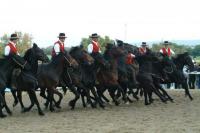Work mount
The working riding differs from the classic English riding due to the long stirrups and the use of the bridle held with one hand.
In Italy the working horse was born in Tuscany and Lazio with slight differences in both style and equipment.
Work riding developed in these regions in ancient times, in companies that hired men who worked with wild cattle, where there was either only one man to tame many horses or a professional was hired only in times of need. In general these limited themselves to giving a first "scozzonatura", that is, a first training "in carrying the man"; once this was done, the horses were immediately given to the riders who refined them directly by working with them among the wild cattle. This training ultimately made the horses agile, versatile, courageous and obedient, capable of moving with the right hand and left hand, in a serpentine or backwards direction. The horses were not afraid of entering water or sudden noises, they knew how to pull weights when necessary, and how to remain still in place when their bridle was on the ground; they were also able to make the steepest descents and climbs without hesitation, and they knew how to come "under", that is, approach a fence from the side to allow the rider to go up or down.
Over time, training techniques have been gradually refined, making working riding a real sporting discipline.
The individual and team competitions are divided into various tests: training, aptitude, gymkhana and "removing", a test which consists of isolating a calf from the herd in the shortest possible time.
